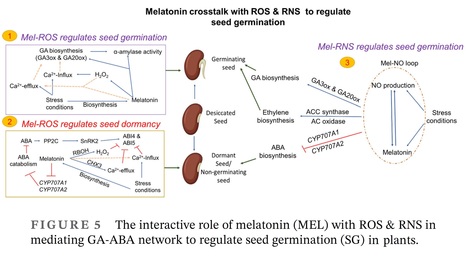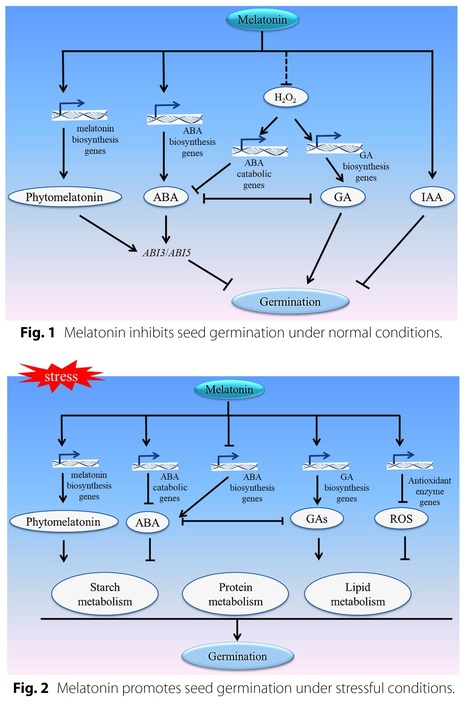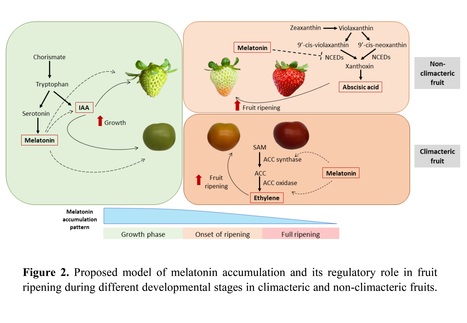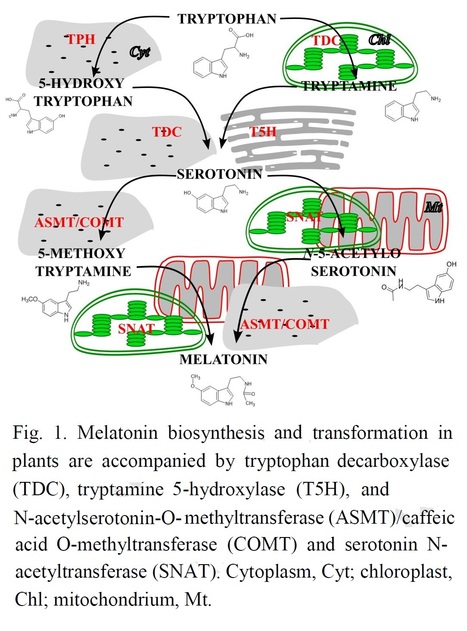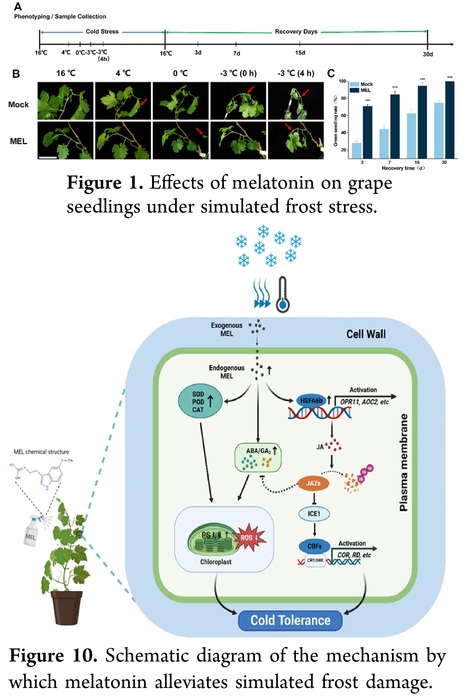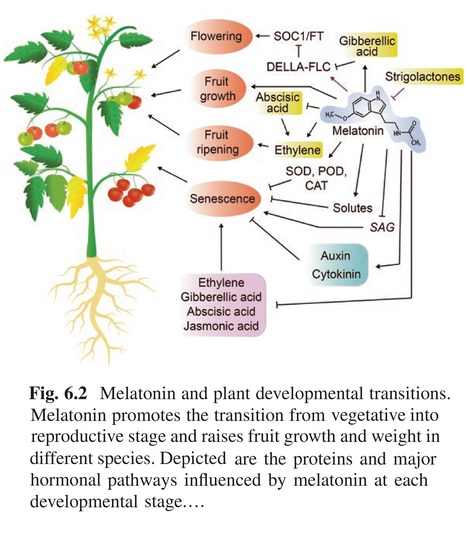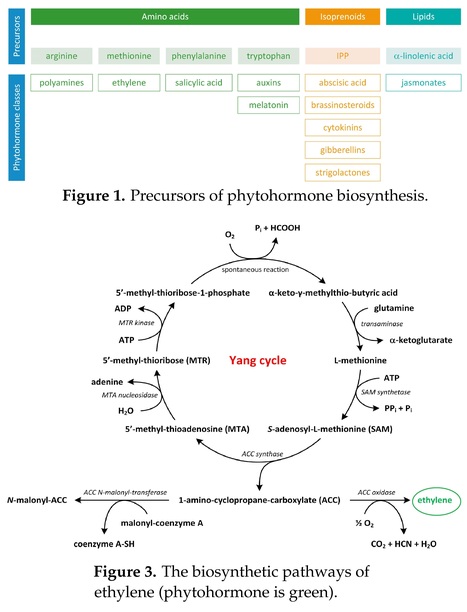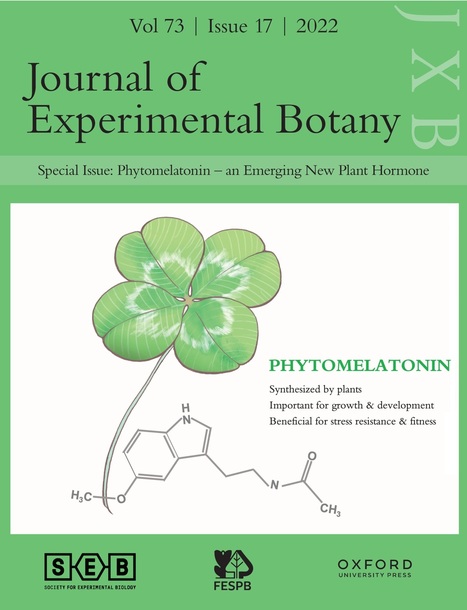 Your new post is loading...
 Your new post is loading...
Authors: Rui Yan, Tianle Zhang, Yuan Wang, Wenxiu Wang, Rahat Sharif, Jiale Liu, Qinglong Dong, Haoan Luan, Xuemei Zhang, Han Li, Suping Guo, Guohui Qi and Peng Jia.
Plant Physiology and Biochemistry (2024)
Highlights: • Seventeen GA2-oxidase genes identified in apple clustered into four clades. • MdGA2ox7 responded to cold and salt treatments. • MdGA2ox7 was activated during light-induced anthocyanin accumulation. • MdGA2ox7 alleviated cold and salt stress damage. • MdGA2ox7 promoted anthocyanin biosynthesis.
Abstract: "Apple (Malus domestica Borkh.) is a widely cultivated fruit crop worldwide but often suffers from abiotic stresses such as salt and cold. Gibberellic acid (GA) plays a pivotal in controlling plant development, environmental adaptability, and secondary metabolism. The GA2-oxidase (GA2ox) is responsible for the deactivation of bioactive GA. In this study, seventeen GA2-oxidase genes were identified in the apple genome, and these members could be clustered into four clades based on phylogenetic relationships and conserved domain structures. MdGA2ox7 exhibited robust expression across various tissues, responded to cold and salt treatments, and was triggered in apple fruit peels via light-induced anthocyanin accumulation. Subcellular localization prediction and experiments confirmed that MdGA2ox7 was located in the cytoplasm. Overexpression of MdGA2ox7 in Arabidopsis caused a lower level of active GA and led to GA-deficient phenotypes, such as dwarfism and delayed flowering. MdGA2ox7 alleviated cold and salt stress damage in both Arabidopsis and apple in concert with melatonin (MT). Additionally, MdGA2ox7 enhanced anthocyanin biosynthesis in apple calli and activated genes involved in anthocyanin synthesis. These findings provide new insights into the functions of apple GA2ox in regulating development, stress tolerance, and secondary metabolism."
Authors: Yanliang Guo and Hao Li.
In Book. "Melatonin in Plants: Role in Plant Growth, Development, and Stress Response" (2024). Editors: Anket Sharma and Golam Jalal Ahammed.
Abstract: "Numerous studies have proven evidence that melatonin plays an important regulatory role in plant growth, development, and defense against various biotic and abiotic stresses. As well as melatonin, plant hormones and many second messengers, such as calcium (Ca2+), reactive oxygen species (ROS), nitric oxide (NO), and hydrogen sulfide (H2S), also play important roles in the regulation of various physiological processes in plants. In recent years, increasing studies have indicated that melatonin interacts with plant hormones and many second messengers to regulate multiple physiological processes. The role of melatonin in regulating seed germination involves abscisic acid (ABA), gibberellins (GA), Ca2+ signal, and H2O2; in regulating stomatal movement involves ABA, Ca2+, ROS, and H2S; in regulating rhizogenesis involves auxin, ROS, and NO; in regulating fruit ripening involves ethylene (ETH), ROS, and NO; in regulating plant senescence involves ABA, cytokinins (CKs), Ca2+, ROS, and NO; in regulating tolerance to abiotic stress involves CK, ABA, ETH, jasmonic acid (JA), and all secondary signals mentioned above; in regulating disease resistance involves ETH, JA, salicylic acid (SA), ROS, and NO. Plant hormones and the second messengers also interact with each other, forming complex regulatory networks, to regulate multiple physiological processes in plants."
Authors: Golam Jalal Ahammed, Zhe Li, Jingying Chen, Yifan Dong, Kehao Qu, Tianmeng Guo, Fenghua Wang, Airong Liu, Shuangchen Chen and Xin Li.
Plant Physiology and Biochemistry (2024)
Highlights: • Reactive oxygen species (ROS) are crucial signaling molecules in plants. • Melatonin is an antioxidant with ROS scavenging potential and a novel plant hormone. • Environmental stress triggers ROS production and melatonin synthesis in plants. • Melatonin can safeguard plants from a wide range of biotic and abiotic stress. • RBOH-derived apoplastic ROS act downstream of melatonin to mediate stress tolerance.
Abstract: "Reactive oxygen species (ROS) are crucial signaling molecules in plants that play multifarious roles in prompt response to environmental stimuli. Despite the classical thoughts that ROS are toxic when accumulate in excess, recent advances in plant ROS signaling biology reveal that ROS participate in biotic and abiotic stress perception, signal integration, and stress-response network activation, hence contributing to plant defense and stress tolerance. ROS production, scavenging and transport are fine-tuned by plant hormones and stress-response signaling pathways. Crucially, the emerging plant hormone melatonin attenuates excessive ROS accumulation under stress, whereas ROS signaling mediates melatonin-induced plant developmental response and stress tolerance. In particular, RESPIRATORY BURST OXIDASE HOMOLOG (RBOH) proteins responsible for apoplastic ROS generation act downstream of melatonin to mediate stress response. In this review, we discuss promising developments in plant ROS signaling and how ROS might mediate melatonin-induced plant resilience to environmental stress."
Via Golam Jalal Ahammed
Authors: Lei Wang, Mohsin Tanveer, Hongling Wang and Marino B. Arnao.
Journal of Pineal Research (2024)
Abstract: "Seed germination (SG) is the first stage in a plant's life and has an immense importance in sustaining crop production. Abiotic stresses reduce SG by increasing the deterioration of seed quality, and reducing germination potential, and seed vigor. Thus, to achieve a sustainable level of crop yield, it is important to improve SG under abiotic stress conditions. Melatonin (MEL) is an important biomolecule that interplays in developmental processes and regulates many adaptive responses in plants, especially under abiotic stresses. Thus, this review specifically summarizes and discusses the mechanistic basis of MEL-mediated SG under abiotic stresses. MEL regulates SG by regulating some stress-specific responses and some common responses. For instance, MEL induced stress specific responses include the regulation of ionic homeostasis, and hydrolysis of storage proteins under salinity stress, regulation of C-repeat binding factors signaling under cold stress, starch metabolism under high temperature and heavy metal stress, and activation of aquaporins and accumulation of osmolytes under drought stress. On other hand, MEL mediated regulation of gibberellins biosynthesis and abscisic acid catabolism, redox homeostasis, and Ca2+ signaling are amongst the common responses. Nonetheless factors such as endogenous MEL contents, plant species, and growth conditions also influence above-mentioned responses. In conclusion, MEL regulates SG under abiotic stress conditions by interacting with different physiological mechanisms."
Authors: Ze Liu, Hengrui Dai, Jinjiang Hao, Rongrong Li, Xiaojun Pu, Miao Guan and Qi Chen.
Stress Biology (2023)
Abstract: "Seed germination is a complex process regulated by internal and external factors. Melatonin (N-acetyl-5-methoxytryptamine) is a ubiquitous signaling molecule, playing an important role in regulating seed germination under normal and stressful conditions. In this review, we aim to provide a comprehensive overview on melatonin's effects on seed germination on the basis of existing literature. Under normal conditions, exogenous high levels of melatonin can suppress or delay seed germination, suggesting that melatonin may play a role in maintaining seed dormancy and preventing premature germination. Conversely, under stressful conditions (e.g., high salinity, drought, and extreme temperatures), melatonin has been found to accelerate seed germination. Melatonin can modulate the expression of genes involved in ABA and GA metabolism, thereby influencing the balance of these hormones and affecting the ABA/GA ratio. Melatonin has been shown to modulate ROS accumulation and nutrient mobilization, which can impact the germination process. In conclusion, melatonin can inhibit germination under normal conditions while promoting germination under stressful conditions via regulating the ABA/GA ratios, ROS levels, and metabolic enzyme activity. Further research in this area will deepen our understanding of melatonin's intricate role in seed germination and may contribute to the development of improved seed treatments and agricultural practices."
Authors: Yongqi Yin, Chunping Wang, Chao Cheng, Zhengfei Yang and Weiming Fang.
Plant Physiology and Biochemistry (2023)
Highlights: • Melatonin biosynthesis was promoted in mustard sprouts under MeJA treatment. • Exogenous MeJA suppressed the growth and development of mustard sprouts. • Exogenous MeJA treatment enriched tryptophan metabolism pathway. • Most of the transcript levels of melatonin synthases markedly increased.
Abstract: "The present study investigated the effects regulating melatonin (MT) biosynthesis under methyl jasmonate (MeJA) treatment in mustard sprouts. The results revealed that MeJA significantly increased the MT content in the sprouts to 11.43 times that of the control. However, MeJA treatment had an inhibitory effect on growth. Tryptophan decarboxylase and tryptamine 5-hydroxylase gene expression were significantly induced by MeJA. Moreover, 156 differential abundance proteins (DAPs) were detected in 4-day-old sprouts using quantitative proteomic methods. These DAPs were divided into 13 functional groups, and the vast majority of DAPs involved in defense/stress, energy, signal transduction, and secondary metabolism increased. MeJA treatment significantly enriched 15 pathways, including glutathione metabolism, biosynthesis of secondary metabolites, and tryptophan metabolism. In particular, the abundance of three DAPs (myrosinase 1, cytosolic sulfotransferase 16, and glutamate-glyoxylate aminotransferase 2) in the tryptophan metabolism pathway, a substrate for MT biosynthesis, increased significantly. In summary, MeJA induces endogenous MT biosynthesis in mustard sprouts by promoting the genes expression of MT synthetase and increasing the abundance of tryptophan-related proteins."
Authors: Rongqing Miao, Zhiqi Li, Yue Yuan, Xiufeng Yan, Qiuying Pang and Aiqin Zhang.
Research Square (2023)
Abstract: Melatonin is a pleiotropic signaling molecule, which besides being involved in various growth and developmental processes and mediates environmental stress responses, but whether and how endogenous melatonin involved in salt response was still unknown. Here, we elucidated the involvement of endogenous melatonin in salt response by the investigation on the loss-of-function mutants of melatonin biosynthesis genes SNAT1 and SNAT2. We found the double mutant snat1snat2 with attenuated melatonin synthesis exhibited salt sensitivity, manifesting by unhealthy plant growth, ion imbalance and ROS accumulation under salt stress. Transcriptomic profiles of snat1snat2showed the expression of large number of salt-responsive genes were affected by SNAT defect, and these genes were closely related to the synthesis of auxin and several signaling pathways. In addition, the salt sensitive growth phenotype of snat1snat2 was alleviated by applying exogenous auxin. Our results show that endogenous melatonin is required for plant salt tolerance, which is correlated with its large activity in mediating auxin signaling.
Authors: Muhammad Saad Shoaib Khan, Sulaiman Ahmed, Aziz ul Ikram, Fakhir Hannan, Muhammad Umair Yasin, Jin Wang, Biying Zhao, Faisal Islam and Jian Chen.
Physiologia Plantarum (2023)
Highlights: • Melatonin acts as a redox network regulator in plants via regulating secondary messengers signaling. • Melatonin regulates the activity of redox-sensitive proteins and transcription factors. • Melatonin influences gene expression and physiological processes in response to stresses. • Melatonin synergically work with other hormones to confer plant resistance and stress adaptability.
Abstract: "Plants being sessile in nature, are exposed to unwarranted threats as a result of constantly changing environmental conditions. These adverse factors can have negative impacts on their growth, development, and yield. Hormones are key signaling molecules enabling cells to respond rapidly to different external and internal stimuli. In plants, melatonin (MT) plays a critical role in the integration of various environmental signals and activation of stress-response networks to develop defense mechanisms and plant resilience. Additionally, melatonin can tackle the stress-induced alteration of cellular redox equilibrium by regulating the expression of redox homeostasis-related genes and proteins. The purpose of this article is to compile and summarize the scientific research pertaining to MT's effects on plants' resilience to biotic and abiotic stresses. Here, we have summarized that MT exerts a synergistic effect with other phytohormones, for instance, ethylene, jasmonic acid, and salicylic acid, and activates plant defense-related genes against phytopathogens. Furthermore, MT interacts with secondary messengers like Ca2+, nitric oxide, and reactive oxygen species to regulate the redox network. This interaction triggers different transcription factors to alleviate stress-related responses in plants. Hence, the critical synergic role of MT with diverse plant hormones and secondary messengers demonstrates phytomelatonin's importance in influencing multiple mechanisms to contribute to plant resilience against harsh environmental factors."
Authors: Yaron Caspi, Chrysoula K. Pantazopoulou, Jeanine J. Prompers, Corné MJ Pieterse, Hilleke Hulshoff Pol and Kaisa Kajala.
eLife (2023)
Editor's view: Recent findings about the possible intercellular signalling role of glutamate, GABA, and melatonin might help to establish hypotheses concerning the evolutionary factors that caused intercellular organisms to use specific molecules in intercellular signalling.
Abstract: "Intercellular signalling is an indispensable part of multicellular life. Understanding the commonalities and differences in how signalling molecules function in two remote branches of the tree of life may shed light on the reasons these molecules were originally recruited for intercellular signalling. Here we review the plant function of three highly studied animal intercellular signalling molecules, namely glutamate, γ-aminobutyric acid (GABA), and melatonin. By considering both their signalling function in plants and their broader physiological function, we suggest that molecules with an original function as key metabolites or active participants in reactive ion species scavenging have a high chance of becoming intercellular signalling molecules. Naturally, the evolution of machinery to transduce a message across the plasma membrane is necessary. This fact is demonstrated by three other well-studied animal intercellular signalling molecules, namely serotonin, dopamine, and acetylcholine, for which there is currently no evidence that they act as intercellular signalling molecules in plants."
Authors: Alba Arabia, Paula Muñoz, Núria Pallarés and Sergi Munné-Bosch.
Plant Physiology (2023)
Abstract: "Phytohormones are naturally occurring small organic molecules found at low concentrations in plants. They perform essential functions in growth and developmental processes, from organ initiation to senescence, including fruit ripening. These regulatory molecules are studied using different experimental approaches, such as performing exogenous applications, evaluating endogenous levels, and/or obtaining genetically modified lines. Here, we discuss the advantages and limitations of current experimental approaches used to study active biomolecules modulating fruit ripening, focusing on melatonin. Although melatonin has been implicated in fruit ripening in several model fruit crops, current knowledge is affected by the different experimental approaches used, which have given different and sometimes even contradictory results. The methods of application and the doses used have produced different results in studies based on exogenous applications, while different measurement methods and ways of expressing results explain most of the variability in studies using correlative analyses. Furthermore, studies on genetically modified crops have focused on tomato (Solanum lycopersicum L.) plants only. However, TILLING and CRISPR methodologies are becoming essential tools to complement the results from the experimental approaches described above. This will not only help the scientific community better understand the role of melatonin in modulating fruit ripening, but it will also help develop technological advances to improve fruit yield and quality in major crops. The combination of various experimental approaches will undoubtedly lead to a complete understanding of the function of melatonin in fruit ripening in the near future, so that this knowledge can be effectively transferred to the field."
Authors: Antía Verde, Jesús M. Míguez and Mercedes Gallardo.
Postharvest Biology and Technology (2022)
Highlights • Melatonin promotes apple colour and flavor during postharvest, extending firmness. • Melatonin increases ethylene production and advances the climacteric burst. • ACC treatment produces similar effects as melatonin on apple ripening parameters. • Ethylene synthesis is a target for melatonin effects on postharvest apple ripening. • Melatonin up-regulates the expression of MdACS1 and MdACO1 genes in apple skin.
Abstract: "Melatonin has been implicated in the regulation of ripening in several types of climacteric fruits, but its role in apple is poorly understood. In this study, the effectiveness of melatonin in influencing postharvest ripening in apples and interacting with ethylene biosynthesis process was investigated. Apples of four local cultivars (Golden, Reineta, Blanquina and Rabiosa) were harvest at an immature green stage and immersed for 120 min in a solution with water (control), melatonin 50 µM, ACC 1 mM, and melatonin 50 µM + ACC 1 mM. The evolution of apple quality parameters and ethylene production was assessed in all cultivars for 35 days after treatment. In addition, Golden apple was used to examine the transcript abundance of ethylene biosynthesis enzymes genes in the skin and flesh. Exogenous melatonin improved apple quality during postharvest ripening and stimulated ethylene production in all cultivars studied, advancing the timing of the climacteric burst. Melatonin-induced changes in ethylene production correlated well with changes in fruit quality and were in part similar to those induced by the ethylene precursor ACC, so ethylene appears to be a target of melatonin. In Golden apple, melatonin stimulated the expression of MdACS1 and MdACO1 genes, which showed a climacteric profile similar to that of ethylene. The transcriptional effects of exogenous melatonin on ethylene-related genes was also more notable in the skin than in the flesh, suggesting an initiating role of the former in the biosynthesis of the phytohormone. Taken together, the results point to the fact that exogenous melatonin may be useful in improving apple quality during postharvest ripening by promoting colour and flavour change and extending fruit firmness. The effect of melatonin appears to be mediated in part by up-regulation of the transcriptional activity of the MdACS1 and MdACO1 genes during the climacteric peak, thus contributing to an increase in ethylene availability."
Authors: Ali Raza, Hajar Salehi, Md Atikur Rahman, Zainab Zahid, Maryam Madadkar Haghjou, Shiva Najafi-Kakavand, Sidra Charagh, Hany S. Osman, Mohammed Albaqami, Yuhui Zhuang, Kadambot H. M. Siddique and Weijian Zhuang.
Frontiers in Plant Science (2022)
Abstract: "Due to global climate change, abiotic stresses are affecting plant growth, productivity, and the quality of cultivated crops. Stressful conditions disrupt physiological activities and suppress defensive mechanisms, resulting in stress-sensitive plants. Consequently, plants implement various endogenous strategies, including plant hormone biosynthesis (e.g., abscisic acid, jasmonic acid, salicylic acid, brassinosteroids, indole-3-acetic acid, cytokinins, ethylene, gibberellic acid, and strigolactones) to withstand stress conditions. Combined or single abiotic stress disrupts the normal transportation of solutes, causes electron leakage, and triggers reactive oxygen species (ROS) production, creating oxidative stress in plants. Several enzymatic and non-enzymatic defense systems marshal a plant’s antioxidant defenses. While stress responses and the protective role of the antioxidant defense system have been well-documented in recent investigations, the interrelationships among plant hormones, plant neurotransmitters (NTs, such as serotonin, melatonin, dopamine, acetylcholine, and γ-aminobutyric acid), and antioxidant defenses are not well explained. Thus, this review discusses recent advances in plant hormones, transgenic and metabolic developments, and the potential interaction of plant hormones with NTs in plant stress response and tolerance mechanisms. Furthermore, we discuss current challenges and future directions (transgenic breeding and genome editing) for metabolic improvement in plants using modern molecular tools. The interaction of plant hormones and NTs involved in regulating antioxidant defense systems, molecular hormone networks, and abiotic-induced oxidative stress tolerance in plants are also discussed."
Authors: Qiaoli Xie, Yu Zhang, Yingxia Cheng, Yanling Tian, Junjie Luo, Zongli Hu and Guoping Chen.
Plant Cell Reports (2022)
Abstract: "Melatonin has attracted widespread attention after its discovery in higher plants. Tomato is a key model economic crop for studying fleshy fruits. Many studies have shown that melatonin plays important role in plant stress resistance, growth, and development. However, the research progress on the role of melatonin and related mechanisms in tomatoes have not been systematically summarized. This paper summarizes the detection methods and anabolism of melatonin in tomatoes, including (1) the role of melatonin in combating abiotic stresses, e.g., drought, heavy metals, pH, temperature, salt, salt and heat, cold and drought, peroxidation hydrogen and carbendazim, etc., (2) the role of melatonin in combating biotic stresses, such as tobacco mosaic virus and foodborne bacillus, and (3) the role of melatonin in tomato growth and development, such as fruit ripening, postharvest shelf life, leaf senescence and root development. In addition, the future research directions of melatonin in tomatoes are explored in combination with the role of melatonin in other plants. This review can provide a theoretical basis for enhancing the scientific understanding of the role of melatonin in tomatoes and the improved breeding of fruit crops."
|
Authors: Minmin He, Gui Geng, Shuyang Mei, Gang Wang, Lihua Yu, Yao Xu and Yuguang Wang.
Functional Plant Biology (2024)
Abstract: "Water stress (drought and waterlogging) leads to an imbalance in plant water distribution, disrupts cell homeostasis, and severely inhibits plant growth. Melatonin is a growth hormone that plants synthesise and has been shown to resist adversity in many plants. This review discusses the biosynthesis and metabolism of melatonin, as well as the changes in plant morphology and physiological mechanisms caused by the molecular defence process. Melatonin induces the expression of related genes in the process of plant photosynthesis under stress and protects the structural integrity of chloroplasts. Exogenous melatonin can maintain the dynamic balance of root ion exchange under waterlogging stress. Melatonin can repair mitochondria and alleviate damage caused by reactive oxygen species and reactive nitrogen species; and has a wide range of uses in the regulation of stress-specific genes and the activation of antioxidant enzyme genes. Melatonin improves the stability of membrane lipids in plant cells and maintains osmotic balance by regulating water channels. There is crosstalk between melatonin and other hormones, which jointly improve the ability of the root system to absorb water and breathe and promote plant growth. Briefly, as a multifunctional molecule, melatonin improves the tolerance of plants under water stress and promotes plant growth and development."
Authors: Izabela Kołodziejczyk and Andrzej Kaźmierczak.
Science of the Total Environment (2024)
Highlights: • Melatonin is a plant biostimulator with promising application potential. • Melatonin is a conserved molecule that performs important functions in all organisms. • As a phytobiostimulant, it upregulates plant growth and development and increases plant tolerance to environmental stresses and thus resistance to unfavourable conditions. • Melatonin may allow human-desired cultivations to be maintained in good condition without introducing unnatural compounds into the environment.
Abstract:"MEL (N-acetyl-5-methoxytryptamine) is a well-known natural compound that controls cellular processes in both plants and animals and is primarily found in plants as a neurohormone. Its roles have been described very broadly, from its antioxidant function related to the photoperiod and determination of seasonal rhythms to its role as a signalling molecule, imitating the action of plant hormones (or even being classified as a prohormone). MEL positively affects the yield and survival of plants by increasing their tolerance to unfavourable biotic and abiotic conditions, which makes MEL widely applicable in ecological farming as a stimulant of growth and development. Thus, it is called a phytobiostimulator. In this review, we discuss the genesis of MEL functions, the presence of MEL at the cellular level and its effects on gene expression and plant development, which can ensure the survival of plants under the conditions they encounter. Moreover, we consider the future application possibilities of MEL in agriculture."
Authors: Rongqing Miao, Zhiqi Li, Yue Yuan, Xiufeng Yan, Qiuying Pang and Aiqin Zhang.
Plant Cell Reports (2024)
Key message: The study on melatonin biosynthesis mutant snat1snat2 revealed that endogenous melatonin plays an important role in salt responsiveness by mediating auxin signaling.
Abstract: "Melatonin is a pleiotropic signaling molecule, which, besides being involved in multiple growth and developmental processes, also mediates environmental stress responses. However, whether and how endogenous melatonin is involved in salt response has not been determined. In this study, we elucidated the involvement of endogenous melatonin in salt response by investigating the impact of salt stress on a double mutant of Arabidopsis (snat1snat2) defective in melatonin biosynthesis genes SNAT1 and SNAT2. This mutant was found to exhibit salt sensitivity, manifested by unhealthy growth, ion imbalance and ROS accumulation under salt stress. Transcriptomic profiles of snat1snat2 revealed that the expression of a large number of salt-responsive genes was affected by SNAT defect, and these genes were closely related to the synthesis of auxin and several signaling pathways. In addition, the salt-sensitive growth phenotype of snat1snat2 was alleviated by the application of exogenous auxin. Our results show that endogenous melatonin may be essential for plant salt tolerance, a function that could be correlated with diverse activity in mediating auxin signaling."
Authors: Junduo Li, Kai Lv, Jieping Wu, Yaping Xie, Junxia Zhang, Ningbo Zhang and Weirong Xu.
Journal of Agricultural and Food Chemistry (2023)
Abstract: "Melatonin (MEL) is an antioxidant molecule that enhances plant tolerance to environmental stress. However, the mechanisms by which MEL regulates cold signaling pathways in grapes under cold stress remain elusive. Here, we investigated the physiological and transcriptomic changes in grape seedlings treated with exogenous MEL to determine their protective role under cold stress. Results showed that 150 μM MEL effectively attenuated cold-induced cell damage by reducing reactive oxygen species (ROS) and preserving the chloroplast structure and function. MEL also inhibited tannin degradation, which contributed to its protective effect. Exogenous MEL promoted the synthesis of endogenous MEL, abscisic acid, auxin, and cytokinin while inhibiting gibberellin. Transcriptomic profiling revealed 776 differentially expressed transcripts in MEL-treated samples compared to controls. Functional analysis of a candidate hub gene, VvHSFA6b, showed that its overexpression in grape calli enhances cold tolerance by activating jasmonic acid synthesis pathway genes, promoting JA accumulation, and inhibiting JAZ-repressed transcription factors."
Authors: Zixi Liu, Ying Chen, Qinglin Xiang, Tao Wang, Lihong Gao and Wenna Zhang.
Vegetable Research (2023)
Abstract: "Low temperature stress has severe detrimental effects on plant growth and crop yield. While the role of phytohormone ABA in regulating cold stress tolerance has been recognized, its underlying regulation mechanisms remain poorly understood. Here, we investigate the involvements of SlMETS1 (Methionine Synthase 1) and SlABO5/6 (ABA Overly-Sensitive 5/6) in response to low temperature stress, and their reliance on the abscisic acid (ABA) pathways using wild-type tomato (WT) and ABA defective mutants not (notabilis) and sit (sitiens). Our findings reveal that cold stress influences the expression of SlMETS1, SlABO5, and SlABO6. The sit mutant exhibits similar expression tendency to the WT. However, the not mutant shows distinctive expression patterns of these three genes. In fact, they respond more rapidly and earlier to cold stress in not compared to the WT and sit. SlMETS1 inhibition by virus-induced gene silencing (VIGS) leads to cold stress sensitivity, resembling ABA defective mutants. These discoveries suggest an association of SlMETS1, SlABO5, and SlABO6 with SlNCED in the ABA biosynthesis and signaling pathways during cold stress, providing new molecular evidence for the relevance between methionine synthesis, ABA signaling, cold tolerance and shoot-root communication in plants."
Authors: Gustavo Ravelo-Ortega, Karen M. García-Valle, Ramón Pelagio-Flores and José López-Bucio.
In book: Melatonin: Role in Plant Signaling, Growth and Stress Tolerance (2023)
Abstract: "In recent years, knowledge has been gained into the mechanisms of action of melatonin in plants and its regulation of morphogenesis. Melatonin accumulates in several organs, such as the root, stem, and leaves, and can be transported from the major site of synthesis in leaves to distant tissues through the vascular bundles, where it affects cell signaling in crosstalk with major phytohormones. The structural similarity of melatonin with indole-3-acetic acid (IAA) led some authors to suggest a potential auxinic effect in plant signal transduction, particularly root branching and stem elongation. However, its physiological roles throughout the life cycle of plants did not support an auxinic role, but in contrast suggest independent mechanisms of action for each molecule, in agreement with the recent discovery of the melatonin receptor CAND2 that differs from the auxin receptors. This chapter describes the recent roles of melatonin in seed germination, root architecture, shoot development, reproduction, and senescence, and the genes and proteins targeted by melatonin signaling. The function of melatonin in these processes goes beyond its function as an antioxidant, and their possible applications represent a valuable input to optimize plant productivity and confer protection against stressing growth conditions."
Authors: Andrzej Bajguz and Alicja Piotrowska-Niczyporuk.
Metabolites (2023)
Abstract: "Phytohormones exhibit a wide range of chemical structures, though they primarily originate from three key metabolic precursors: amino acids, isoprenoids, and lipids. Specific amino acids, such as tryptophan, methionine, phenylalanine, and arginine, contribute to the production of various phytohormones, including auxins, melatonin, ethylene, salicylic acid, and polyamines. Isoprenoids are the foundation of five phytohormone categories: cytokinins, brassinosteroids, gibberellins, abscisic acid, and strigolactones. Furthermore, lipids, i.e., α-linolenic acid, function as a precursor for jasmonic acid. The biosynthesis routes of these different plant hormones are intricately complex. Understanding of these processes can greatly enhance our knowledge of how these hormones regulate plant growth, development, and physiology. This review focuses on detailing the biosynthetic pathways of phytohormones."
Authors: Vishnu Mishra and Ananda K. Sarkar.
Physiologia Plantarum (2023)
Abstract: "Serotonin is a well-studied pineal hormone that functions as a neurotransmitter in mammals and is found in varying amounts in diverse plant species. By modulating gene and phytohormonal crosstalk, serotonin has a significant role in plant growth and stress response, including root, shoot, flowering, morphogenesis, and adaptability responses to numerous environmental signals. Despite its prevalence and importance in plant growth and development, its molecular action, regulation, and signalling processes remain unknown. Here, we highlight the current knowledge of the role of serotonin-mediated regulation of plant growth and stress response. We focus on serotonin and its regulatory connections with phytohormonal crosstalk and address their possible functions in coordinating diverse phytohormonal responses during distinct developmental phases, correlating with melatonin. Additionally, we have also discussed the possible role of microRNAs (miRNAs) in the regulation of serotonin biosynthesis. In summary, serotonin may act as a node molecule to coordinate the balance between plant growth and stress response, which may shed light on finding its key regulatory pathways for uncovering its mysterious molecular network."
Authors: Jianghua Cai, Dongqi Li and Asaph Aharoni
The Plant Journal (2023)
Abstract: "Plants developed sophisticated mechanisms to perceive environmental stimuli and generate appropriate signals to maintain optimal growth and stress responses. A fascinating strategy employed by plants is the use of long-distance mobile signals which can trigger local and distant responses across the entire plant. Some metabolites play a central role as long-distance mobile signals allowing plants to communicate across tissues and mount robust stress responses. In this review, we summarize the current knowledge regarding the various long-distance mobile metabolites and their functions in stress response and signaling pathways. We also raise questions with respect to how we can identify new mobile metabolites and engineer them to improve plant health and resilience."
Authors: Yanliang Guo, Jingyi Zhu, Jiahe Liu, Yuxing Xue, Jingjing Chang, Yong Zhang, Golam Jalal Ahammed, Chunhua Wei, Jianxiang Ma, Pingfang Li, Xian Zhang and Hao Li.
Plant, Cell & Environment (2023)
Abstract: "Precocious leaf senescence can reduce crop yield and quality by limiting growth stage. Melatonin has been shown to delay leaf senescence; however, the underlying mechanism remains obscure. Here, we show that melatonin offsets abscisic acid (ABA) to protect photosystem II and delay the senescence of attached old leaves under the light. Melatonin induced H2O2 accumulation, accompanied by an upregulation of melon respiratory burst oxidase homolog D (CmRBOHD) under ABA-induced stress. Both melatonin and H2O2 induced the accumulation of cytoplasmic free Ca2+ ([Ca2+]cyt) in response to ABA, while blocking of Ca2+ influx channels attenuated melatonin- and H2O2-induced ABA tolerance. CmRBOHD overexpression induced [Ca2+]cyt accumulation and delayed leaf senescence, whereas, deletion of Arabidopsis AtRBOHD, a homologous gene of CmRBOHD, compromised the melatonin-induced [Ca2+]cyt accumulation and delay of leaf senescence in Arabidopsis under ABA stress. Furthermore, melatonin, H2O2 and Ca2+ attenuated ABA-induced K+ efflux and subsequent cell death. CmRBOHD overexpression and AtRBOHD deletion alleviated and aggravated the ABA-induced K+ efflux, respectively. Taken together, our study unveils a new mechanism by which melatonin offsets ABA action to delay leaf senescence via RBOHD-dependent H2O2 production that triggers [Ca2+]cyt accumulation and subsequently inhibits K+ efflux and delays cell death/leaf senescence in response to ABA."
Authors: Qi Chen and Marino B. Arnao.
Journal of Experimental Botany (2022)
Abstract: Melatonin (N-acetyl-5-methoxytryptamine) synthesized by plants is known as phytomelatonin. It was first detected by several independent research groups in 1995 (Dubbels et al., 1995; Hattori et al., 1995; Kolar et al., 1995; Van Tassel et al., 1995). The biosynthesis of melatonin in animals and plants begins from tryptophan via several similar consecutive enzymatic steps. The first phytomelatonin receptor, PMTR1, was identified in Arabidopsis in 2018 (Wei et al., 2018). Recently, several independent research groups have discovered that PMTR1 and its homologous proteins are required for perceiving phytomelatonin signaling in stomatal closure, seed germination and seedling growth, flowering, leaf senescence, and in responding to various biotic and abiotic stresses in Arabidopsis, tobacco, alfalfa, maize, and cassava (Bai et al., 2022; Chen et al., 2022). Phytomelatonin is therefore comparable to the more well-known plant hormones and regulates nearly all aspects of plant life history (Box 1).
Authors: Chengliang Sun, Nan Sun, Yiqun Ou, Biao Gong, Chongwei Jin, Qinghua Shi and Xianyong Lin.
Journal of Experimental Botany (2022)
Abstract: "Plant mineral nutrition is critical for agricultural productivity and human nutrition. However, the availability of mineral elements is heterogeneous spatially and temporally in many ecosystems and agricultural landscapes. Nutrient imbalances trigger intricate signalling networks that modulate plant acclimation responses. One signalling agent of particular importance in such networks is melatonin, a pleiotropic molecule with multiple functions. Evidence indicates that nutrient deficiency or excess generally increases melatonin levels in particular tissues, and melatonin is increasingly thought to participate in the regulation of plant mineral nutrition. Alterations in endogenous melatonin levels could protect plants from oxidative stress, influence root architecture, and enhance the nutrient uptake and use efficiency through transcriptional and post-transcriptional regulation; such changes optimise mineral nutrient acquisition and ion homeostasis inside plant cells for plant growth promotion. This review summarises the current information on the regulation of plant mineral nutrition by melatonin and emphasises how endogenous melatonin alters plant responses to specific mineral elements. Furthermore, we comprehensively discuss how melatonin enhances nutrient uptake and transport under conditions of nutrient shortage."
|




 Your new post is loading...
Your new post is loading...




